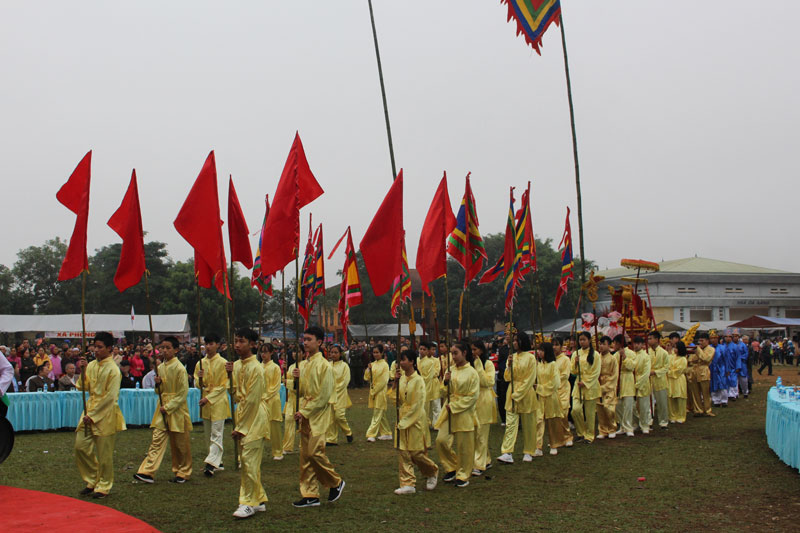



The procession group of the Saint palanquin from the temple to the festival grounds at the Khai Ha Festival in Muong Bi (Tan Lac) in 2019.
Each festival has its own beauty of identity, belief, and tradition, bearing the mark of each ethnic group, each region, such as the Khai Ha festival of Muong Bi (Tan Lac), Muong Dong Festival (Kim Boi), Muong Thang festival (Cao Phong), Du Voi festival (Lac Son), De Rice Tet of Muong Ram (Yen Thuy), the festival of Xen Ban - Xen Muong of Thai people (Mai Chau), Gou Tao festival of Mong ethnic people (Mai Chau), the festival of spraying for rice crop of Tay ethnic people (Tay Bac), dancing Tet, Cap Sac Ceremony for men (A ceremony to acknowledge the men’s maturity)... Besides, at temples and pagodas the traditional festivals at the beginning of the year are organized for the people’s spring travel, sightseeing and worship such as: the festival of Tien pagoda (Lac Thuy), the festival of Bo temple (Da Bac), the festival of Ngoi communal (Hoa Binh city), the communal festival of Voi village (Lac Thuy) ), the festival of Coi temple (Lac Son) ...
The features in the folk festivals often show the connection of the community, the solidarity and the attachment of a village and a region. The festival is usually divided into 2 parts, the ceremony and the festival. The ceremony is often solemnly and respectfully held with the religious colour. The festival is organized with many cultural activities, arts, sports, folk games, cuisine ... Depending on each region, each ethnic group, the ritual performance is different, but all activities are solemnly and respectfully organized, expressing the tribute, the respect for the ancestors, the gods, the people who have built the villages and Muong, giving thanks and praying for favourable rain and wind, good crops, a new year full of warmth, happiness and peace.
Mentioning the special festivals of the province, it is impossible not to mention Khai Ha festival. It is also known as the ceremony to go to the field, the opening ceremony of the forest, the folk festival associated with water rice agriculture, bearing a lot of marks relating to the ancient Vietnamese civilization. This festival is an indispensable activity of Muong ethnic people. Khai Ha festival is a start for a new year, because after this ritual, the local people start the farming work or forest gathering and hunting ...
The festivals are often associated with the specific geographic, natural and social characteristics of the long-existing resident communities. The restoration, conservation and promotion of the traditional festivals, especially at the beginning of spring not only honour and preserve the historical and cultural values to meet the people's need to enjoy culture, but also contribute to promoting and introducing the cultural identity of the ethnic people in Hoa Binh province to domestic and international tourists.